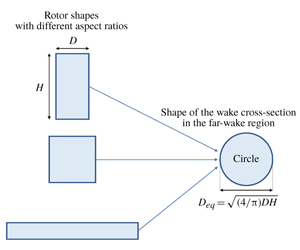Crossref Citations
This article has been cited by the following publications. This list is generated based on data provided by
Crossref.
Guo, Jia
and
Lei, Liping
2020.
Flow Characteristics of a Straight-Bladed Vertical Axis Wind Turbine with Inclined Pitch Axes.
Energies,
Vol. 13,
Issue. 23,
p.
6281.
Eshagh Nimvari, Majid
Fatahian, Hossein
and
Fatahian, Esmaeel
2020.
Performance improvement of a Savonius vertical axis wind turbine using a porous deflector.
Energy Conversion and Management,
Vol. 220,
Issue. ,
p.
113062.
Pucci, Micol
Bellafiore, Debora
Zanforlin, Stefania
Rocchio, Benedetto
and
Umgiesser, Georg
2020.
Embedding of a Blade-Element Analytical Model into the SHYFEM Marine Circulation Code to Predict the Performance of Cross-Flow Turbines.
Journal of Marine Science and Engineering,
Vol. 8,
Issue. 12,
p.
1010.
Posa, Antonio
2021.
Secondary flows in the wake of a vertical axis wind turbine of solidity 0.5 working at a tip speed ratio of 2.2.
Journal of Wind Engineering and Industrial Aerodynamics,
Vol. 213,
Issue. ,
p.
104621.
Posa, Antonio
2021.
Analysis of momentum recovery within the near wake of a cross-flow turbine using Large Eddy Simulation.
Computers & Fluids,
Vol. 231,
Issue. ,
p.
105178.
Villeneuve, Thierry
and
Dumas, Guy
2021.
Impact of some design considerations on the wake recovery of vertical-axis turbines.
Renewable Energy,
Vol. 180,
Issue. ,
p.
1419.
Ouro, Pablo
and
Lazennec, Maxime
2021.
Theoretical modelling of the three-dimensional wake of vertical axis turbines.
Flow,
Vol. 1,
Issue. ,
Yagmur, Sercan
Kose, Faruk
and
Dogan, Sercan
2021.
A study on performance and flow characteristics of single and double H-type Darrieus turbine for a hydro farm application.
Energy Conversion and Management,
Vol. 245,
Issue. ,
p.
114599.
Xu, Wenhao
Li, Ye
Li, Gaohua
Li, Shoutu
Zhang, Chen
and
Wang, Fuxin
2021.
High-resolution numerical simulation of the performance of vertical axis wind turbines in urban area: Part II, array of vertical axis wind turbines between buildings.
Renewable Energy,
Vol. 176,
Issue. ,
p.
25.
Villeneuve, Thierry
Winckelmans, Grégoire
and
Dumas, Guy
2021.
Increasing the efficiency of vertical-axis turbines through improved blade support structures.
Renewable Energy,
Vol. 169,
Issue. ,
p.
1386.
Bouzaher, Mohamed Taher
and
Guerira, Belhi
2022.
Computational Investigation on the Influence of Expandable Blades on the Performance of a Savonius Wind Turbine.
Journal of Solar Energy Engineering,
Vol. 144,
Issue. 6,
Kuang, Limin
Lu, Qi
Huang, Xuan
Song, Leijian
Chen, Yaoran
Su, Jie
Han, Zhaolong
Zhou, Dai
Zhao, Yongsheng
Xu, Yuwang
and
Liu, Yijie
2022.
Characterization of wake interference between two tandem offshore floating vertical-axis wind turbines: Effect of platform pitch motion.
Energy Conversion and Management,
Vol. 265,
Issue. ,
p.
115769.
Bouzaher, Mohamed Taher
and
Guerira, Belhi
2022.
Impact of Flexible Blades on the Performance of Savonius Wind Turbine.
Arabian Journal for Science and Engineering,
Vol. 47,
Issue. 12,
p.
15365.
Reddy, K. Bheemalingeswara
Bhosale, Amit C.
and
Saini, R.P.
2022.
Performance parameters of lift-based vertical axis hydrokinetic turbines - A review.
Ocean Engineering,
Vol. 266,
Issue. ,
p.
113089.
Huang, Ming
Ferreira, Carlos
Sciacchitano, Andrea
and
Scarano, Fulvio
2022.
Wake scaling of actuator discs in different aspect ratios.
Renewable Energy,
Vol. 183,
Issue. ,
p.
866.
Vahidi, Dara
and
Porté-Agel, Fernando
2022.
A New Streamwise Scaling for Wind Turbine Wake Modeling in the Atmospheric Boundary Layer.
Energies,
Vol. 15,
Issue. 24,
p.
9477.
Jooss, Yannick
Bolis, Roberto
Bracchi, Tania
and
Hearst, R. Jason
2022.
Flow field and performance of a vertical-axis wind turbine on model buildings.
Flow,
Vol. 2,
Issue. ,
Huang, Guoqing
Zhang, Senqin
Yan, Bowen
Yang, Qingshan
Zhou, Xuhong
and
Ishihara, Takeshi
2022.
Thrust-matched optimization of blades for the reduced-scale wind tunnel tests of wind turbine wakes.
Journal of Wind Engineering and Industrial Aerodynamics,
Vol. 228,
Issue. ,
p.
105113.
Bouzaher, Mohamed Taher
2022.
Effect of flexible blades on the Savonius wind turbine performance.
Journal of the Brazilian Society of Mechanical Sciences and Engineering,
Vol. 44,
Issue. 2,
Posa, Antonio
2022.
Wake characterization of paired cross-flow turbines.
Renewable Energy,
Vol. 196,
Issue. ,
p.
1064.

 ${\textstyle \frac{1}{4}}$) and the same thrust coefficient (
${\textstyle \frac{1}{4}}$) and the same thrust coefficient ( $C_{T}=0.8$). After observing the obvious differences in these three wakes, by using the classical momentum integral and the concept of momentum diameter, we come up with an appropriate normalization length scale
$C_{T}=0.8$). After observing the obvious differences in these three wakes, by using the classical momentum integral and the concept of momentum diameter, we come up with an appropriate normalization length scale  $D_{eq}=\sqrt{(4/\unicode[STIX]{x03C0})DH}$, where
$D_{eq}=\sqrt{(4/\unicode[STIX]{x03C0})DH}$, where  $D$ is the rotor diameter and
$D$ is the rotor diameter and  $H$ is the rotor height. By normalizing the lengths (both streamwise and lateral) involved in the mean velocity profiles by
$H$ is the rotor height. By normalizing the lengths (both streamwise and lateral) involved in the mean velocity profiles by  $D_{eq}$, we obtain a remarkable collapse of the wake profiles for the three aspect ratios. As a corollary, cross-sections of wakes of turbines with different aspect ratios eventually converge to a circular shape – not an elliptical one, for example, as one might presume intuitively. This result influences the modelling of VAWT far wakes and, in turn, has implications on the optimal configuration of VAWT farms.
$D_{eq}$, we obtain a remarkable collapse of the wake profiles for the three aspect ratios. As a corollary, cross-sections of wakes of turbines with different aspect ratios eventually converge to a circular shape – not an elliptical one, for example, as one might presume intuitively. This result influences the modelling of VAWT far wakes and, in turn, has implications on the optimal configuration of VAWT farms.